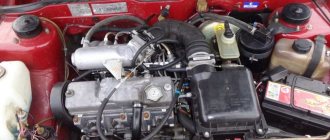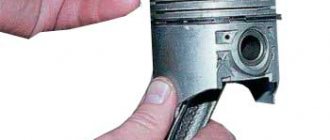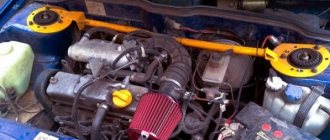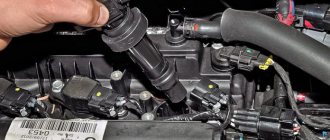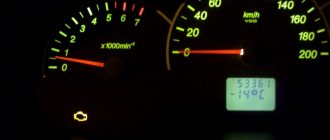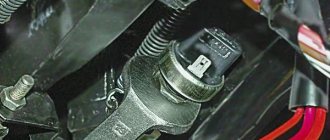“Trippling” of the VAZ-2109 engine is a term denoting a malfunction of the power plant that occurred as a result of failure and interruptions in the operation of one of the cylinders. This breakdown is quite common and occurs in engines with both carburetor and injection power systems.
Signs
“Tripling” appears on the VAZ-2109 in the form of:
- Unstable motor operation.
- Strong vibration.
- Power drops.
- Difficulty starting.
- The appearance of “pops” in the exhaust system.
“Tripping” is not a critical engine failure, and the car can be driven, at least to get to the repair site. But you shouldn’t delay repairs, since improper operation of one of the engine cylinders will ultimately lead to serious problems.
Reasons why the engine stalls
First
: at speeds above 1200-1300 rpm, engine shaking may stop. In this case, shaking may occur due to the afterburning system or the power system. But the ignition remains in a normal (working) state and no malfunctions occur, this is explained by an increase in engine speed, the carburetor systems immediately come into operation, there are several of these systems, which means that they will not all break down at once. In the event that air begins to leak through the gap as the speed increases, the excess air will have a much smaller negative impact on the operation of all systems. This option cannot be ruled out; the engine may shudder from time to time. The reason is the lack of operation of one of the cylinders. The same can be said about a malfunction in the ignition. For the formation of a spark at idle speed, the established requirements are much higher than at speeds above 2000 rpm. Therefore, even the slightest defect in the ignition system will lead to engine shaking.
Second
: Shaking can also appear as a result of improper operation of the carburetor or injector. Shaking that occurs when the power system fails can appear due to an overly rich mixture or, conversely, a too lean mixture. Leaning of the mixture occurs more often than enriching it; this problem arises due to the appearance of excess air that enters the power system, after and into the combustion chamber. But unfortunately, this malfunction can appear on relatively new engines. And on older engines, another reason may be insufficient fuel level. In order to determine the level, rock the car a little. If the level in the window cannot be seen even when swinging, it means that it is completely filled with fuel. As a result, the carburetor is overfilled. If the carburetor is always overfilled, the exhaust gases will be black in color.
It is acceptable if the fuel level slightly exceeds the permissible limit. In this case, the reason lies in fatigue or even deformation of the tip on the needle itself, which controls the fuel supply at the right moments.
Identification of an idle cylinder
The method for identifying a bad cylinder depends on the type of engine power system.
In carburetor engines, the determination of a failed cylinder is carried out experimentally. The essence of the method is to turn off each cylinder one by one by removing the tip of the high-voltage wire from the spark plug while the unit is running.
The check should begin with the 1st cylinder on a warm engine and with the speed set at 1500 rpm. If, after removing the tip, the speed drops significantly (the engine stops altogether, since as a result 2 cylinders will be switched off), the 1st cylinder is working normally.
Next, the test is carried out on the following cylinders. If the cylinder is not running, removing the tip will not affect the operation of the motor. After turning off the “drawdown” there will be no revolutions.
This test method is simple and allows you to accurately determine which cylinder is not working. But when doing it, follow safety precautions. High-voltage wires carry electrical impulses with high voltage but low current. These impulses will not cause damage to health, but the sensations are not pleasant.
As for the VAZ-2109 engine with an injector, the experimental method should not be used here (so as not to affect the operation of electronic systems). On such engines, the determination of an inoperative cylinder is carried out by scanning the ECU for errors. Interruptions in the operation of the motor are monitored by electronic systems and recorded in the form of error codes, by deciphering which we find out what caused the disruption of the normal functioning of the unit.
Video: VAZ-2109. The engine is shaking!
How to determine the cause of tripling
If you remove the tip from the spark plug, then when you reduce the idle speed, you will be able to verify the operation of the cylinder, but when checking in this way, there is a possibility of damaging the switch, and it may also pierce the cover of the slider or distributor. An electric shock from explosive wires is unlikely, if not even possible, but the tips should still be removed using pliers with insulated handles. If the carburetor engine shakes at idle, then very slowly pull the throttle cable with your hand, thereby increasing the speed to 3000 rpm. As soon as such a breakdown is detected, remove the air filter to gain free access to the carburetor. To avoid inconvenience caused by exhaust gases, we close the manifold outlet pipe, you can plug it with a plastic screwdriver handle. After carrying out this procedure and increasing the speed, different engine reactions may occur.
Checking the ignition system
The reason that the VAZ-2109 engine “troubles” is the ignition system. Due to its incorrect operation, the combustion process of the air-fuel mixture is not observed in one of the cylinders, which leads to unstable operation of the engine, severe vibration, and a drop in power.
Interruptions in the ignition system, due to which “triple” occurs, give:
- Candles.
- High-voltage wires and their tips.
- Contacts of the distributor cover (distributor).
- Hall Sensor.
These items should be checked in the same order.
Candles are one of the most common causes of tripping. Exhausted life, incorrect clearance, “breakdown” of the housing and penetration of the impulse to ground - these faults of the spark plug lead to failure or malfunction, which affects the operation of the motor.
You can verify that a spark plug is broken by replacing it with a known good one or swapping it with a spark plug from another cylinder. Replacing the spark plug can eliminate the malfunction of the power unit.
In addition to the spark plug, you should check the condition of the contact in the tip (which is put on the contact nut of the spark plug). It is made of copper and oxidizes over time, which leads to disruption of contact between the wire and the spark plug, and causes “triple” to appear.
In search of the cause, the high-voltage wires are checked next. Over time, the braiding of these wires loses elasticity and cracks, which is why voltage pulses “break through” to the ground, not reaching the spark plug.
A simple way to check the wires is to start the engine at night and open the hood. In the dark, “breakdowns” in the form of sparks are visible. If sparks are noticeable, replace the wires.
Next, look at the distributor cap and the slider. Gradually, the contacts on the slider and in the lid wear out, and they may also oxidize, which leads to loss of contact and interruptions in the operation of the spark plug.
Due to a malfunction of the Hall sensor, there is a failure in the formation of pulses supplied to the switch. Because of this, the operation of the ignition system is disrupted, in which the pulse from the coil to the distributor is missed, and from it to the spark plug.
Do not forget that an incorrectly set ignition timing is another reason for engine tripping. Therefore, in search of the cause, we be sure to check the setting of this angle and carry out adjustment work.
Why does the engine of a VAZ 2109 car troit?
The reason that the engine on the VAZ 2109 is misfiring is the uneven combustion of fuel in a single cylinder. The reasons for this may be:
- The ignition timing is set incorrectly.
- There has been a malfunction in the vacuum corrector system for ignition distribution or in the carburetor accelerator pump.
- The spark plugs have become unusable.
- A high-voltage wire has broken.
- Capacitor failure.
- There is a leak in the intake manifold or carburetor.
- Burnt pistons or valves.
- The piston rings are broken.
- Valves incorrectly adjusted.
- The gasket in the cylinder head has broken.
- The valve stem seals are worn, hardened or destroyed.
- Use of very low quality fuel.
- The carburetor is not adjusted correctly.
- The distributor shaft and the rotary plate bearing are worn out.
- The membrane of the vacuum ignition accelerator has lost its tightness.
- There are other reasons why the engine of the VAZ 2109 troits.
How to eliminate some causes of engine tripping
If during the initial period of movement of a VAZ 21093 car the engine stalls, most likely the accelerator pump or the vacuum corrector of the ignition distributor has broken down. In this case, diagnostics of components is carried out and, if necessary, repair or replacement of elements. To work you will need:
- Wrenches for “10” and “8”.
- Slotted and Phillips screwdrivers.
- Clean rags.
- Copper wire without an insulating layer with a diameter of up to 0.3 mm.
- Compressor.
- Liquid type WD40.
Order of operations:
- The air filter cover is removed. To do this, unscrew the nut with a “10” key and unfasten the spring clips.
- The air filter is pulled out. Use a key “8” to unscrew the four nuts, use a screwdriver to loosen the clamp on the crankcase ventilation hose at the place where it is connected to the valve cover and remove the housing from the air filter.
- The hose is disconnected from the vacuum corrector drive for ignition distribution. The tightness of the assembly is checked by creating a vacuum of air through the mouth.
Checking the tightness of the vacuum corrector drive
- If air passes through, the unit needs to be replaced. Otherwise you need to:
- Look inside the carburetor. The air damper must be completely open. When you press the throttle control lever, a stream of fuel should appear from the two nozzle tubes of the accelerator pump. They should be level, directed into the space between the opening damper and the diffuser wall. The photo shows the holes for the fuel outlet.
Carburetor with cover removed
- If there is no fuel outlet, you need to remove the hoses supplying fuel to the carburetor and drain it.
- The torso is detached to control the air damper.
- The wire located on the idle air solenoid valve is removed.
- Unscrew the screws holding the top carburetor cover.
- The lid is removed and placed with the floats facing up.
- Carefully pry off the atomizer with a screwdriver and pull it out of the socket.
- Use a thin copper wire to clean the atomizer nozzle holes.
- The atomizer is blown with air in the opposite direction of the direction of fuel movement.
- The element is installed in place.
- Without installing the assembly cover, you need to press the drive lever for the throttle valve. Fuel streams should appear from the two nozzle tubes of the acceleration pump.
- If they are not there, you need to check the absence of play in the drive and the accelerator pump drive lever and its ease of movement. To facilitate work, the parts are lubricated with WD40 type fluid. Parts that have become unusable are replaced with new ones.
- The operation of the accelerator pump is re-checked.
- The carburetor is assembled in reverse order.
- If there are no streams again, you need to contact a car service.
Malfunctions of the CPG and timing belt
Problems in the cylinder-piston group and gas distribution mechanism are another reason for interruptions in engine operation. This malfunction occurs when:
- occurrence of rings;
- piston burnout;
- burning of the valve plates and their seats.
Malfunctions of the CPG and timing, due to which the engine “trips” appear, are determined by measuring compression in the cylinders. A cylinder that operates intermittently has a lower compression rate than the rest.
Next, we establish the reason for the drop in compression. To do this, pour 20-30 g through the spark plug hole of the cylinder. engine oil, after which we take compression measurements again.
An increased compression ratio indicates the occurrence of rings. We eliminate this problem by decarbonizing the motor.
If the repeated measurement again shows low compression, you will have to remove the cylinder head to determine the cause of the malfunction.
The reason for the “triple” of the power unit can also be a breakdown of the cylinder head gasket. Due to this malfunction, a loss of compression occurs in the cylinder due to depressurization of the combustion chamber.
Elimination methods
It is worth understanding that tripling on a carburetor power unit will occur not only while driving, but also at idle speed. In this case, the motor will make sounds like popping noises. But the car will twitch only while driving. So, it’s worth going directly to the analysis of the process of diagnosing and troubleshooting.
Carburetor
Unlike injection engines, a carburetor is a rather finicky thing that is sensitive to fuel and the technical condition of parts. Therefore, many motorists know that the power unit can stall precisely because of the carburetor. This version of the car was equipped with an injection element marked Solex, with which many are familiar.
To cure the shaking and jerking of the car, you will have to sort out and clean the carburetor. The cleaning process occurs manually or using a special oven that heats the cleaning liquid. But, as practice shows, most car enthusiasts who clean carbs with their own hands do the process completely manually.
Also, when overhauling, you will need a Solex carburetor repair kit, designed for cars of the VAZ 2108-21099 family.
Calibration data for the carburetor installed on VAZ 2108, VAZ 2109, VAZ 21099 vehicles
After the carburetor has been rebuilt, it needs to be adjusted. Adjustment is carried out using quality and quantity screws until the optimal ratio of fuel supplied to the chamber for forming the air-fuel mixture is achieved.
If for an injection engine the poor quality of fuel is even more or less tolerable and you can drive, then for a carburetor engine it is a disaster. Bad fuel not only clogs the jets, but also quickly damages the fuel pump.
Poor quality gasoline can be identified immediately, since the engine begins to “chug”, traction disappears, and if you open the float chamber of the carburetor, the liquid called gasoline will be sticky and will not pass through the nozzles well.
To eliminate the problem, you will have to disassemble and clean the entire fuel system, including the removal of the fuel tank. After cleaning, you need to fill in, albeit expensive, but high-quality gasoline and drive 50-60 kilometers to clean the valve mechanism and piston group.
Although this may no longer help, since the valves and pistons are burned out, and this is precisely the reason. Then a major overhaul of the engine will be required.
Fuel pump and filter
Another reason that the engine starts to stall is an insufficient or intermittent supply of fuel to the carburetor. In this case, the problem will lie precisely in the fuel pump or a dirty filter element.
Therefore, it is recommended to check these elements for functionality. If necessary, repair the fuel pump and replace the fuel filter.
A missing spark is a sign of a malfunction of the ignition system. Namely, spark plugs, wires or a coil could have failed. Spark plugs are checked on a special spark plug stand, but if there is none, then it is necessary to inspect the elements for damage, measure gaps and resistance. If a malfunction is detected, replace damaged parts.
During the diagnostic process, high-voltage wires are measured for resistance and also inspected for damaged insulation. If you find that one or more wires are broken, they should be replaced. The new wire should have a resistance of 5 ohms.
Air filter
The air filter has repeatedly caused the tripping effect. So, this element must be changed every 20,000 km. It is untimely replacement that leads to problems with the formation of the air-fuel mixture.
If the VAZ 2109 engine carburetor begins to triple and twitch, or traction disappears, then the reason should be sought in the formation of the air-fuel mixture or the ignition system. You can even fix this problem yourself, since the motor is quite simple in design.
Brake booster failure
The vacuum brake booster (VUT) of the VAZ 2109 is not formally related to the operation of the cylinders. But failure of the VUT can lead to failure of the third cylinder. The engine will start to stall.
The vacuum booster is designed to reduce the force on the brake pedal required to effectively slow down the vehicle. To do this, VUT uses rarefied air, which it takes from the intake manifold. The intake hose fitting, equipped with a check valve, is located near the combustion chamber of the third cylinder. It is this cylinder that stops working if the amplifier fails or if the supply hose is damaged.
Due to the damage, atmospheric air is sucked in, the mixture becomes leaner, and ignition does not occur. Often, malfunctions in the operation of the brake pedal are accompanied by a significant increase in the force on the brake pedal; it becomes “dull” and does not provide proper deceleration. It happens that when you press the brake pedal, the engine stops revving and runs normally, but when you release the pedal, the third cylinder fails again. All of these are sure signs of a VUT malfunction, and they require your immediate response.
It is quite simple to make sure that the reason for the failure of the third cylinder lies in the amplifier.
| Remove the VUT hose from the engine intake manifold fitting. | Take a short bolt with a diameter slightly smaller than the inner diameter of the fitting channel. Wrap several layers of electrical tape around the bolt stem and plug the hole. |
| Start the engine. | If it stops tripping, the reason is precisely the faulty VUT. |
| Inspect the supply hose. | Often, damage to the hose occurs at the fixing clamp itself, where the hose is strongly bent. In this case, it is often possible to trim it by 1.5–2.0 cm and eliminate the leak. |
| It is impossible to repair a failed vacuum booster with your own hands. | It must be replaced. |
If you have a spare amplifier, replacing the unit yourself is not difficult and can be done by yourself. If you go to the service, be careful: in fact, you are driving with faulty brakes.
Reason No. 1 – no spark is supplied to the cylinder:
- Irregularities in the spark plug. It may make its way onto the body or its gap may be set incorrectly. To control the correct operation of the spark plug, you need to unscrew it and lean it against any metal part. After that, by turning the starter, we determine by eye whether sparks appear on the spark plug. It is taken with pliers; Rubber gloves should be worn on hands. Anyone who has been hit by a 20 kV shock will fully agree that safety is absolutely necessary. Remember that although there is a spark jumping on an unscrewed spark plug, this is not a 100% indicator of its correct operation. After all, the cylinder has a completely different environment.
- Wire breakdown. If it breaks through, the spark will become extremely insignificant or disappear completely. I mentioned safety due to the fact that in my case, the factor that caused the carburetor in the VAZ 2109 to malfunction and the engine to not pull was precisely the breakdown. I began to move the wire with the engine running and took it with my unprotected hands. When receiving an electric shock, a person is unable to release the wire on his own. It was lucky that an acquaintance was nearby. Be carefull!
- There is a problem with the car's ignition distributor. For example, a contact burned out or mechanical wear occurred. This can lead to the fact that a spark from the distributor stops going to a specific cylinder.
- Hall Sensor. If it is not fully operational, it is capable of transmitting pulses from the drum on the car distributor shaft and not sending them to the switching device. That is, sparks will be missed.
What other reasons could there be for the malfunction of carburetors 2108, 21081, 21083, 2109
- The channels and jets of the carburetor idle system are clogged
- Low fuel level in the carburetor float chamber
- The air filter element is clogged. The degree of contamination should be quite high. Replace it with a new one.
- The power system before entering the carburetor is faulty
- Fuel pump is faulty
- The filters in the power supply system are clogged. This is a filter on the fuel intake in the gas tank, a fine fuel filter and a mesh filter in the carburetor.
- Power system elements are damaged
- Ignition system is faulty
- Spark plugs are faulty
- The distributor (cover, slider) is faulty
- High voltage wires are faulty
- The ignition timing is not set correctly
- The power supply system is faulty
- Short circuit in wiring
- Thermal clearances in the valve mechanism are broken
- Marks in the timing system are shifted
- Wear of the piston group (breakage or stuck rings, wear of cylinders)
- Valves burnout
Before you begin to identify the causes of engine tripping at idle, it is necessary to conduct a visual inspection of its engine compartment. A loose wire, a chip not fully inserted, a kinked hose, etc. will not allow the engine to work normally, and will take away the time and effort of the car owner spent on troubleshooting.
